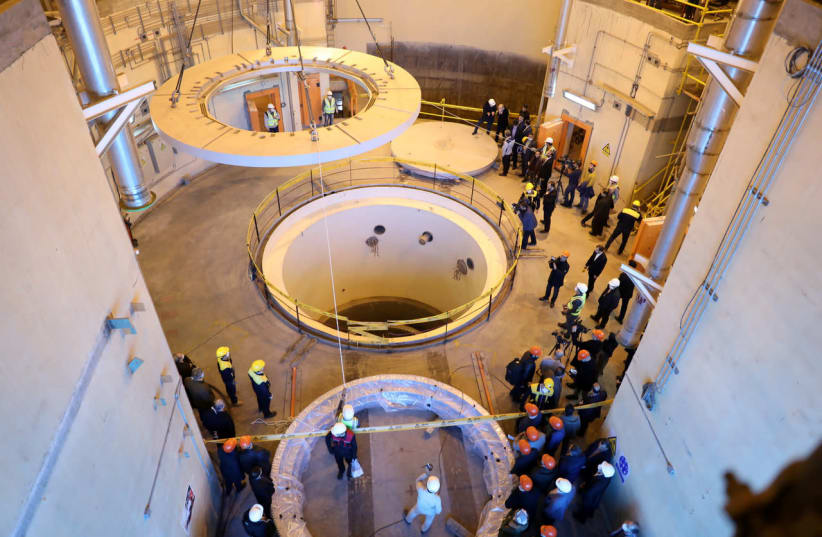Iran's announcement that it would enrich uranium up to the 60% level made waves globally at a level of magnitude far above any of its prior threats.
The question is whether the Islamic Republic has the capacity to actually carry out the threat as well as a threat to install an additional 1,000 first generation centrifuges for enriching uranium on top of the 5,060 it has been operating.
On Thursday, the IAEA said that Tehran was already deep into preparations to make its threats a reality.
If Iran can pull off its threat, the challenge would be very serious because the 60% level would bring it much closer to breaching the threshold for a nuclear bomb.
In order for uranium to be weaponized, it must be enriched to 90%.
Under the 2015 nuclear deal, Iran had to stay below 5% nuclear enrichment.
However, both before the nuclear deal and since the Islamic Republic started violating the deal in 2019-2020, it has enriched some of its uranium stock to a mid-level 20%.
Even the jump to 20% set off alarms globally as taking a major additional step toward a nuclear weapon - especially since there is no viable civilian use for 20% enriched uranium.
But to date, Iran has not enriched uranium up to 60%, often referred to as the next level for jumping toward a nuclear weapon.
Former IDF intelligence chief Aharon Ze’evi Farkash told The Jerusalem Post that “I would treat the announcement at this point as a signal of intent to improve its [Iran’s] negotiating hand on the eve of returning to negotiations this week in Vienna with the EU-3.”
In other words, he was far from convinced that Iran would carry out the threat or would do it on a scale that would significantly shorten its clock to developing a nuclear weapon.
Rather, the threat or any 60% enrichment could be minimal and symbolic so as not to risk getting so close to the nuclear threshold that Israel might feel the need to launch a major preemptive strike.
Separately, sources told the Post on Tuesday that the announcement might be a bluff to save face.
However, “If they really did start to enrich at 60% and with the more advanced and faster IR-6 centrifuges, then from the moment of the decision, the process could be shortened to six months,” from two years, said Farkash.
As a reference point, when Farkash talks about six months or two years, he means including solving all issues beyond uranium enrichment, such as solving how to deliver a nuclear weapon on a conventional missile.
Prior to the 60% enrichment threat, most US and Israeli officials estimated the clock for the stage of enriching to the 90% weaponized level at three months.
Israeli intelligence estimated the full process, including both enrichment and delivery, at two years.
This would mean that the time to get to weaponized uranium would become shorter than the current three-month estimate, while the full process two years estimate would be reduced to six months.
President of the Institute for Science and International Security David Albright told the Post, “In theory, if Iran has sufficient 60 percent enriched uranium for one nuclear weapon, it could break out ten times faster compared to the situation when it starts with enough 3.5 to 4.5 percent enriched uranium for a nuclear weapon (and no pre-existing 20 or 60 percent enriched uranium).”
In other words, in a vacuum, 60% enriched uranium could shorten the nuclear breakout process by a factor of 10.
At the same time, Albright cautioned, “The breakout times will shift after the recent attack [on Natanz last week, reportedly by the Mossad], but I do not know the extent of damage,” and so he did not want to give a hard estimate.
Albright was even more doubtful or unclear about the issue of Iran’s threat to install 1,000 additional first-generation IR-1 centrifuges.
Farkash also pointed out that Iran could shorten the time even under six months if it used centrifuges at both the Natanz and Fordow facilities.
The former IDF intelligence chief recalled that Iran in theory could operate up to 60,000 centrifuges at Natanz if it assembled that many.
About 13,000 centrifuges are currently disassembled, such that its total current centrifuge fleet, if reactivated, is around 20,000.
Basically, the idea is that, given time, the Islamic Republic could massively increase its enrichment capacity.
Yet, like Albright, Farkash was unsure about what impact last week’s attack on Natanz would have on Tehran’s ability to operate either previous centrifuges or install new centrifuges, let alone enrich uranium up to 60%.
Reports indicate that thousands of centrifuges were damaged and that Iran’s nuclear efforts could be delayed by as much as nine months by losing its electric power at Natanz.
How will any centrifuges operate without electricity?
However, there are so many moving pieces to the nuclear program that a delay in one piece might not prevent a jump forward on another front.
Farkash is doubtful that the Islamic Republic will jump forward too far at Fordow as action at that underground facility might also force Israel’s hand.
The picture is extremely ambiguous and fluid.
Israel will need to keep a close eye on both the new moves at Iranian nuclear facilities and the ongoing negotiations in Vienna, which still may be Iran’s true focus.
